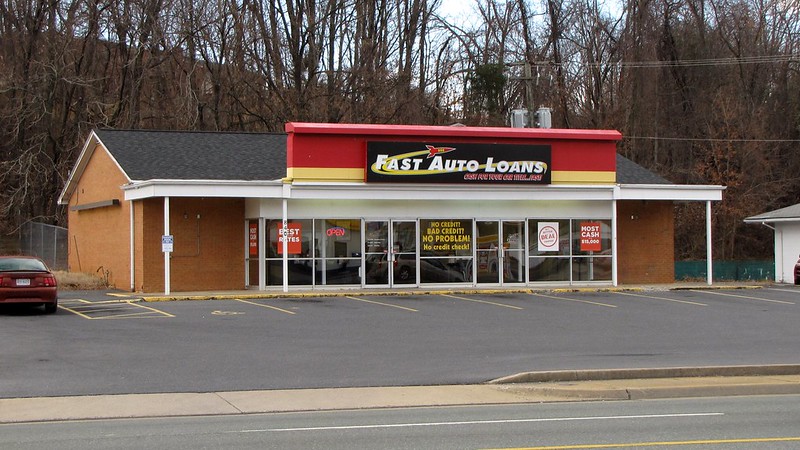Photo Credit: Ben Schumin || Looks like a place where you may get a fast deal, but not the best deal.
Remember 125% LTV loans on houses prior to the financial crisis? Well, auto loans now are their twin separated at birth. The Wall Street Journal wrote an article recently about those who lend more than 100% on automobiles.
Now, in the old days, auto loans were short. They were shorter than five years, and never more than 80% of the value of the car. This meant that the balance of auto loan would always be less than the depreciated value of the car under ordinary circumstances.
But as has been common in American history, we always test the limits in lending. Maturities have been lengthened and loan-to-value ratios expanded. If you need a car, and your current loan is more than the value of the car you want to trade in, some lender will be willing to roll the loss into the value of the loan to purchase the next car, with a higher interest rate to compensate for the added risk.
Why is the risk higher? Auto loans are collateralized by the car. If you don’t pay, the repo man comes and takes the car. If the car is worth less than the loan, the borrower is liable for the difference. When the difference is big, the lender will pursue the borrower for payment, and either get the payment, or send the borrower into bankruptcy. The costs of bankruptcy to the borrower means losing the car and not being able to borrow for seven years or so.
But there will be costs to the lender as well. In a financial crisis, most of them will go bankrupt themselves. They aren’t thickly capitalized, and can’t afford a lot of losses. That’s part of the price of making low quality loans.
What to do
The first step in doing well here is to buy a cheap car that is of reasonable quality, even if it isn’t fashionable. I have only once paid more than $11,000 for a car, and that was for a 15-seat Ford XLT Van that last 14 years for me. Typically these days, I buy refurbished cars that have been through a wreck, and carry a salvage title. I would say, “You don’t need to look good,” but I look just fine. I pay very little for cars, and they last well.
Part of the challenge is finding honest auto dealers who charge a reasonable markup over their costs. Ask your smart friends for advice. (If you don’t have smart friends, get some.) Part of the price of the method that I use is that few lenders will lend on “salvage title” vehicles, so I have to pay cash. It is better to borrow unsecured at a high rate and buy a cheap but quality salvage title car than to buy an expensive vehicle from a regular dealer.
There is a hidden cost to buying salvage title cars though. If there is an accident and it is totaled, the insurer will pay you far less than for a similar non-salvage title vehicle.
Don’t Borrow to Buy a Car
This is the simplest advice. When I was 27, my parents came to visit me in California. My Father looked at the two used cars that my wife and I owned, and praised me — “You haven’t bought a lot of fancy rolling stock.”
I have never taken out an auto loan. I never will. Borrowing should only be for things that don’t depreciate, like a house.
People need to get over the idea that their car has to be powerful or pretty, and focus on buying cars that are reliable. Paying less for a car is one of the easiest ways to save money, so long as you get a quality car.
Avoid Owning Shares in Auto Lenders
I don’t know who you have to avoid here. I can’t think of a pure play. If you know of one, please mention it in the comments. I simply know that those who lend without adequate security eventually get hosed.
You would think we would have learned from the Financial Crisis, but the more I look at current conditions, the more I think we are short-sighted.
We are not facing a banking crisis now, but maybe we might around 2030. The banks are mostly in good shape now, but perhaps we might see the failure of some non-bank lenders in the next recession who have lent too much on autos.
In summary, try to avoid borrowing on a car, and don’t own companies who lend more than 100% on a car.
PS — three articles that I have written on buying cars:


Credit Acceptance Corp (ticker CACC) is a pure play on subprime auto loans.
Santander Consumer (Ticker: SC). Much riskier than CACC
Cars, like boats, motor homes and horses, are financial black holes, into which consumers regularly throw too much money. In addition to always paying cash for a car (and no leasing), never buy more car than you need. That lovely mid-size SUV with the round, blue and white emblem, will cost you 2 to 3 times much as will a suitable Asian import. Ego value, you say? Even that has been largely discounted as the roads are thick today with over priced vehicles. And, here’s the kicker: at the end of your vehicle’s life, that fancy car will be worth about as much the cheaper model. Be smart: buy something less expensive and invest the difference. In 5-10 years, you’ll have earned enough to buy your next car.